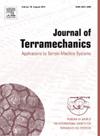轮式军用卡车通过后不同土壤类型的自然恢复:土壤作为后续机动作战地面的意义
IF 3.7
3区 工程技术
Q3 ENGINEERING, ENVIRONMENTAL
引用次数: 0
摘要
越野军用车辆的贩运会造成土壤条件紊乱。因此,前作战地区会对后续行动产生严重影响。更确切地说,不平整的土壤表面会显著增加行驶车辆的振动,过度压实和移位的土层会影响土壤水分动态,进而对土壤强度产生长期影响。此外,土壤作为植物的栖息地,必须为植物生长提供空气、水和养分。幸运的是,由于冰冻-解冻周期、湿润-干燥周期和生物活动的作用,土壤受到扰动后可以自然恢复。不过,恢复速度取决于土壤的物理参数。本研究的目的是监测和总结土壤的自然恢复率。作为一项实验,使用军用卡车(总重量 70 千牛)进行了单次通行和多次通行。对形成的车辙进行了监测,并收集了车轮碾压两年后的土壤样本。在整个研究恢复期间,在实验室测量了车辙深度、锥体指数值、容重、土壤含水量以及实地饱和导水率,并测定了土壤孔径分布。本文介绍了不同土壤的自然恢复结果。本文章由计算机程序翻译,如有差异,请以英文原文为准。
Natural recovery of different soil types after passes by wheeled military truck: Implications for soil as a ground for follow-on mobility operations
The trafficking of off-road military vehicles generates disturbed soil conditions. Thus, former active combat areas can have a serious effect on subsequent operations. More precisely, an uneven soil surface will remarkably increase the vibration of travelling vehicles, and over-compacted as well as displaced soil layers affect soil water dynamics that, in turn, have a long-lasting effect on soil strength. In addition, soil as a habitat for plants must provide air, water, and nutrients for the plants to grow. Luckily, soil can naturally recover from being disturbed thanks to freezing-thawing cycles, wetting–drying cycles, and biological activity. However, the rate of recovery depends on the physical parameters of soil. The objective of this study was to monitor and summarize the natural recovery rate of soils. As an experiment, single pass and repeated passes with military trucks (total weight 70 kN) were carried out. The ruts that formed were monitored and soil samples were collected up to 2 years after wheeling. The rut depth, cone index values, bulk density, soil moisture content as well as field-saturated hydraulic conductivity were measured and soil pore size distribution was determined in a laboratory during the entire studied recovery period. The results about the natural recovery on different soils are presented herein.
求助全文
通过发布文献求助,成功后即可免费获取论文全文。
去求助
来源期刊

Journal of Terramechanics
工程技术-工程:环境
CiteScore
5.90
自引率
8.30%
发文量
33
审稿时长
15.3 weeks
期刊介绍:
The Journal of Terramechanics is primarily devoted to scientific articles concerned with research, design, and equipment utilization in the field of terramechanics.
The Journal of Terramechanics is the leading international journal serving the multidisciplinary global off-road vehicle and soil working machinery industries, and related user community, governmental agencies and universities.
The Journal of Terramechanics provides a forum for those involved in research, development, design, innovation, testing, application and utilization of off-road vehicles and soil working machinery, and their sub-systems and components. The Journal presents a cross-section of technical papers, reviews, comments and discussions, and serves as a medium for recording recent progress in the field.
 求助内容:
求助内容: 应助结果提醒方式:
应助结果提醒方式:


